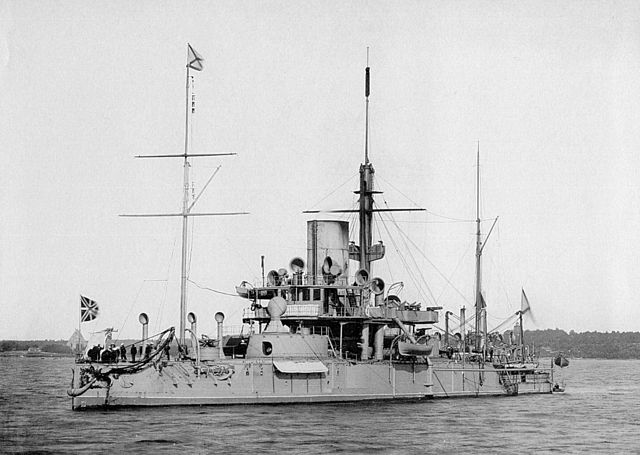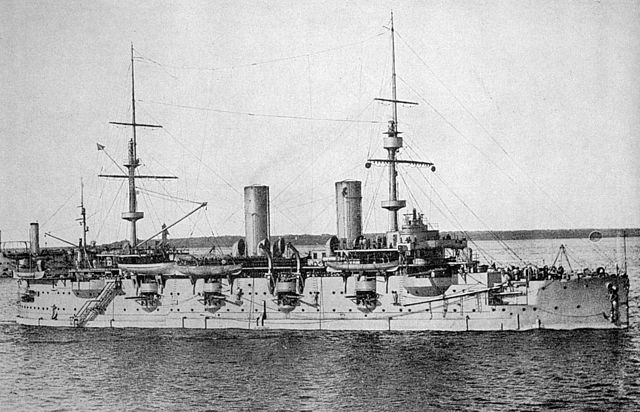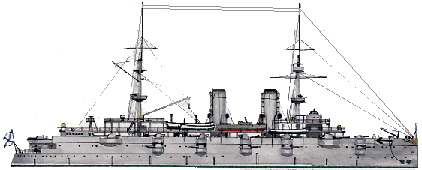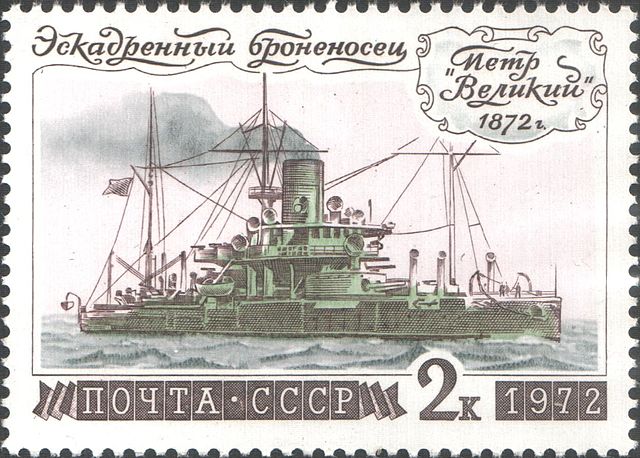The ironclad babochka:
The Petr Velikiy (Peter the Great) was undoubtedly the oldest Russian battleship in service in 1914, the babochka (“Grandma”) of the Russian navy. This battleship knew several lives. It was in its day the very first Russian battleship with turrets and steam alone, a fashion launched by France and Great Britain and quickly followed by the tsar for the Baltic fleet.

Petr Velikiy in service in the late 1870s
The Russian Ironclad
Probably the biggest and most modern Russian warship drawn in the late 1860s, the Пётр Великий – Peter the Great, was an ironclad turret ship, started in july 1870 at Galerniy Island Shipyard, Saint Petersburg and launched 27 August 1872, for over 5.5 million rubles. The plans betrayed a strong British influence, notably the contemporary HMS Dreadnought (1st) class ironclad of similar configuration, but was initially inspired by the American twin-turret monitor USS Miantonomoh when visiting Kronstadt in August 1866. Rear Admiral A. A. Popov was its designer, and initially proposed a low-freeboard breastwork monitor with full rigging. Peter the Great was completed however in 1876 with a revised design.
From monitor to sea-going Ironclad
From the initial hybrid monitor-cruiser design, submitted to the Naval Technical Committee in 1867, the design evolved as it was ordered the coal carried to be raised from four to five days steaming, triggering design modifications. The design was revised 26 January 1869, but other changes were added by Popov himself, like a central superstructure forward of the breastwork to improve seakeeping and overhanging side armor. The revised design was again submitted and approved in 19 June 1869 but meanwhile the displacement made a jump from 7,496 long tons to 9,462 long tons. While building started, new changed were made to “Kreiser” (cruiser), the rigging was deleted, spar torpedoes added, and after a visit and advice from naval architect Edward Reed, armour was increased to 14in (356 mm). The ship was then renamed in 1872 to celebrate the bicentennial of Peter the Great, founder of the Baltic feet.
Design
Popov’s ironclad was just 100.5 m long at the waterline (330 feets), and on completion her displacement rose to 10,406 long tons (10,573 t). For rigidity and protection, she was subdivided by one centerline and longitudinal, nine transverse and two wing watertight bulkheads, plus complete double bottom. She had a low freeboard and rolled a lot, generally considered as a passable sea-boat. She also had two three-cylinder horizontal return connecting rod-steam engines, each with a propeller. Each was fed by 12 rectangular boilers (36 psi) for a total of 9,000 nominal horsepower (6,700 kW) and a top speed of 13 knots (24 km/h; 15 mph) and 1900 nm of range thanks to a reserve of 1230 tons of coal. Boilers proved of frail construction and showed numerous defects, as built by Scottish-funded St Petersburg Baird Works. Sea trials showed it could only reach 11 knots, and the chimney was raised by about 20 feet, but with little effect.
The main armament comprised four muzzle-loading smoothbore 20-inch (508 mm) guns (US. Rodman design), but eventually, an enlarged version of the German 280mm Krupp was chosen, to produce a 12-inch, 20-caliber type. Rather than the muzzles, the hydraulic turret machinery raised and lowered the guns’ trunnions. Range, at 12.5° was 5,800 yards (5,300 m). The 360 long tons (370 t) Coles type turrets fully revolved in a minute although because of the superstructure, only 310° was practical. Secondary armament was defensive against torpedo-boats, six 4 pdr (3.4-inch (86 mm)) guns (4 bridge, 2 stern), and two Palmcrantz 1 pdr (1-inch (25 mm)) Gatling-type machine guns. There were in addition four telescopic spar-torpedoes mounted in the bow, which mostly acted as a ramming deterrent for other ships.
First service period (1877-1905)
Early on, in the context of the Russo-Turkish war of 1877 and British threat, two 9-inch mortars were fitted on her quarterdeck, later removed in 1880. After many complaints about the machinery (Baird works received a penalty), John Elder & Co., in Glasgow, Scotland, in October 1880 was contracted. Refitting lasted to February 1882. In addition to be reliable and lighter, the machinery allowed the ship to reach 14.36 knots (26.59 km/h; 16.53 mph).
She departed Scotland for a Mediterranean cruise, visiting many ports, then headed north, before reaching Kronstadt on 12 September. In the mid-1880s two 44-millimeter (1.7 in) Engstrem guns replaced the rear deck 4 pdrs, her boilers were replaced in 1892, and by the mid-1890s, four additional 4-pdr were added to each turret, plus six 47 mm (1.9 in) 5-barrel revolving Hotchkiss guns (bridge) four 37mm (1.5 in) Hotchkiss guns (deck). Considered obsolete by then, several reconstruction proposals were made. Eventually, this was postponed until a new minister of the Marine came at the office and decided to convert her as a gunnery training ship.

Petr Velikiy as rebuilt
Reconstruction (1905)
The reconstruction plan was approved on 2 February 1904. In 1905-1906 she was entirely rebuilt, with new machines and boilers, two chimneys, two light masts, a high freeboard thanks to a completely redesigned hull, a displacement reduced to 9790 tons and a new armament: Exit the antique 305mm, the artillery now included 4 x 203 mm on the upper deck at the four corners, and 12 x 152 mm on the lower deck in casemates. The rest consisted of small pieces on the main deck.
Petr Veliky was now 321 feet 10 inches (98.09 m) long overall, 62 feet 4 inches (19.0 m) wide, with a 26 feet 7 inches (8.1 m) draft. Displacement was reduced to 9,790 long tons (9,950 t). Top speed was 12.9 knots (23.9 km/h; 14.8 mph) for 714 long tons (725 t) of coal and 1,500 nautical miles (2,800 km; 1,700 mi) range.
The Petr Velikiy at war (1914-18)
She was completed the following year of the Russo-Japanese war. She was in 1914 assigned to the Baltic fleet, but played a secondary role, mainly coastguard and part of the Gunnery Training Detachment through 1917 as planned.
In February 1917 she could have been was renamed Respublikanets or Barrikada (Barricade), by the Soviets (still unconfirmed). Retired afterwards, she was completely disarmed in October 1918 and converted as a depot ship for submarines at Kronstadt, then Helsinki. It was subsequently used as a mines carrier and was renamed Barrikada. Hulked on 21 May 1921 she was used to store mines. Renamed Blokshiv Nr. 1 on 4 December 1923 she was forced aground in shallow water by autumn floods in September 1923. She was refloated and repaired in 5 October 1927 and in January 1932 renamed Blokshiv Nr. 4, then BSh-3 (1949) barrack ship at Kronstadt. She was eventually stricken on 18 April 1959 and scrapped, after a 80+ years long career.
Specifications (1914) |
|
| Dimensions (L-w-h) | 101.7 x 19.2 x 7.5 m 333’8”x63′ x24’9” |
| Total weight, fully loaded | 10,406 long tonnes |
| Armament | 2×2 305mm (12 in), 6x 4pdr, 2x 1pdr HMG, 4 spar Torpedoes |
| Armor |
Belt: 8–14 in (203–356 mm) Citadel: 14 in (356 mm) Deck: 2.5–3 in (64–76 mm) Gun turrets: 14 in (356 mm) |
| Crew | 24 officers + 417 sailors |
| Propulsion | 2 shafts, 2 HRC rod-steam engines, 12 rectangular boilers, 8,258 ihp (6,158 kW) |
| Speed (road) | 13 knots (24 km/h; 15 mph) |
| Range | 2,900 nm (5,400 km; 3,300 mi) @10 knots (19 km/h; 12 mph) |
Gallery

Illustration profile of the Petr Veliki as of 1914

Petr Velikiy on a stamp from 1974.



 Latest Facebook Entry -
Latest Facebook Entry -  X(Tweeter) Naval Encyclopedia's deck archive
X(Tweeter) Naval Encyclopedia's deck archive Instagram (@navalencyc)
Instagram (@navalencyc)





 French Navy
French Navy Royal Navy
Royal Navy Russian Navy
Russian Navy Armada Espanola
Armada Espanola Austrian Navy
Austrian Navy K.u.K. Kriegsmarine
K.u.K. Kriegsmarine Dansk Marine
Dansk Marine Nautiko Hellenon
Nautiko Hellenon Koninklije Marine 1870
Koninklije Marine 1870 Marinha do Brasil
Marinha do Brasil Osmanlı Donanması
Osmanlı Donanması Marina Do Peru
Marina Do Peru Marinha do Portugal
Marinha do Portugal Regia Marina 1870
Regia Marina 1870 Nihhon Kaigun 1870
Nihhon Kaigun 1870 Preußische Marine 1870
Preußische Marine 1870 Russkiy Flot 1870
Russkiy Flot 1870 Svenska marinen
Svenska marinen Søværnet
Søværnet Union Navy
Union Navy Confederate Navy
Confederate Navy Armada de Argentina
Armada de Argentina Imperial Chinese Navy
Imperial Chinese Navy Marinha do Portugal
Marinha do Portugal Mexico
Mexico Kaiserliche Marine
Kaiserliche Marine 1898 US Navy
1898 US Navy Sovietskiy Flot
Sovietskiy Flot Royal Canadian Navy
Royal Canadian Navy Royal Australian Navy
Royal Australian Navy RNZN Fleet
RNZN Fleet Chinese Navy 1937
Chinese Navy 1937 Kriegsmarine
Kriegsmarine Chilean Navy
Chilean Navy Danish Navy
Danish Navy Finnish Navy
Finnish Navy Hellenic Navy
Hellenic Navy Polish Navy
Polish Navy Romanian Navy
Romanian Navy Turkish Navy
Turkish Navy Royal Yugoslav Navy
Royal Yugoslav Navy Royal Thai Navy
Royal Thai Navy Minor Navies
Minor Navies Albania
Albania Austria
Austria Belgium
Belgium Columbia
Columbia Costa Rica
Costa Rica Cuba
Cuba Czechoslovakia
Czechoslovakia Dominican Republic
Dominican Republic Haiti
Haiti Hungary
Hungary Honduras
Honduras Estonia
Estonia Iceland
Iceland Eire
Eire Equador
Equador Iran
Iran Iraq
Iraq Latvia
Latvia Liberia
Liberia Lithuania
Lithuania Mandchukuo
Mandchukuo Morocco
Morocco Nicaragua
Nicaragua Persia
Persia San Salvador
San Salvador Sarawak
Sarawak Uruguay
Uruguay Venezuela
Venezuela Zanzibar
Zanzibar Warsaw Pact Navies
Warsaw Pact Navies Bulgaria
Bulgaria Hungary
Hungary

 Bundesmarine
Bundesmarine Dutch Navy
Dutch Navy Hellenic Navy
Hellenic Navy Marina Militare
Marina Militare Yugoslav Navy
Yugoslav Navy Chinese Navy
Chinese Navy Indian Navy
Indian Navy Indonesian Navy
Indonesian Navy JMSDF
JMSDF North Korean Navy
North Korean Navy Pakistani Navy
Pakistani Navy Philippines Navy
Philippines Navy ROKN
ROKN Rep. of Singapore Navy
Rep. of Singapore Navy Taiwanese Navy
Taiwanese Navy IDF Navy
IDF Navy Saudi Navy
Saudi Navy Royal New Zealand Navy
Royal New Zealand Navy Egyptian Navy
Egyptian Navy South African Navy
South African Navy






























 Ukrainian Navy
Ukrainian Navy dbodesign
dbodesign